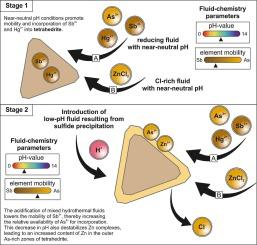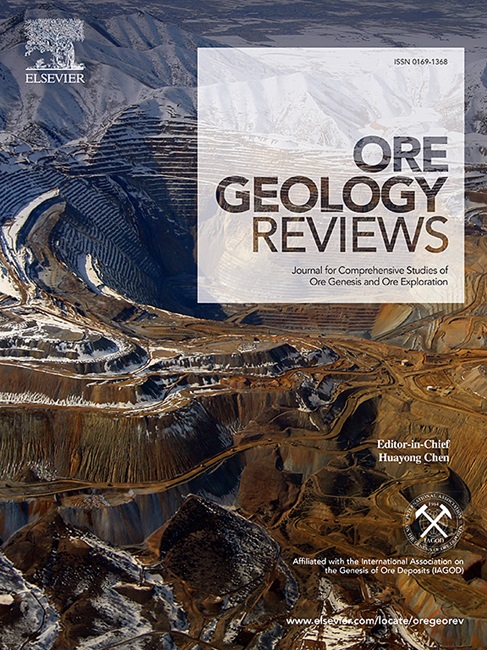Tetrahedrite-(Hg) from the Litija deposit, Central Slovenia: Mineral chemistry insights into fluid evolution processes
IF 3.2
2区 地球科学
Q1 GEOLOGY
引用次数: 0
Abstract
For over a century, the main carrier of Silver in the Litija mineralisation has been debated, with fine-grained galena often identified as the primary host. The in-situ quantitative microanalysis of a silver-bearing ore from the Alma orebody reveals that silver is not hosted within the galena but occurs instead as inclusions within tetrahedrite-(Hg). The mechanism of silver incorporation in tetrahedrite is complex and may occur through atom-to-atom substitution, where monovalent silver replaces monovalent copper (Ag+ ↔ Cu+). Additionally, silver can be present as a separate phase, either as nanoscale inclusions of acanthite or through the replacement of pre-existing silver-rich chalcopyrite. Elemental correlations and minor variations in the element distribution within the studied tetrahedrite provide insights into the chemistry of the mineralizing fluid. These findings suggest an initial reducing, near-neutral, low-chlorinity fluid promoting incorporation of Sb3+ and Hg2+ into tetrahedrite. This fluid subsequently mixed with high-salinity, Cl-rich, near-neutral fluid transporting Zn2+. Sulfide precipitation introduced additional acidity in the mixed fluids, altering the pH and promoting As3+ and Zn2+ incorporation into tetrahedrite. We suggest that Hg2+ ↔ Zn2+ substitution in tetrahedrite is influenced by pH fluctuations and fluid mixing. These findings provide new insights into the geochemical processes governing trace element incorporation in sulfosalt minerals and offer valuable framework for understanding mineralization in similar hydrothermal systems worldwide.

斯洛文尼亚中部 Litija 矿床的四面体(汞):矿物化学对流体演化过程的启示
一个多世纪以来,人们一直在争论 Litija 矿化物中银的主要载体,通常认为细粒方铅矿是主要的载体。对阿尔马矿体的含银矿石进行的原位定量显微分析表明,银并不赋存于方铅矿中,而是以包裹体的形式存在于四面体(Hg)中。银在四面体中的掺入机制很复杂,可能是通过原子对原子的置换作用,即一价银取代一价铜(Ag+ ↔ Cu+)。此外,银还可以作为单独的相存在,可以是尖晶石的纳米级包裹体,也可以是通过置换先前存在的富银黄铜矿而产生的。所研究的四面体中的元素相关性和元素分布的微小变化为矿化流体的化学性质提供了启示。这些发现表明,最初的还原性、近中性、低氯流体促进了 Sb3+ 和 Hg2+ 与四面体矿石的结合。这种流体随后与高盐度、富含 Cl、接近中性的流体混合,输送 Zn2+。硫化物沉淀在混合流体中引入了额外的酸性,改变了 pH 值,促进了 As3+ 和 Zn2+ 与四面体的结合。我们认为,四面体中Hg2+ ↔ Zn2+的置换受pH值波动和流体混合的影响。这些发现为研究微量元素掺入硫盐矿物的地球化学过程提供了新的视角,并为了解全球类似热液系统的成矿过程提供了宝贵的框架。
本文章由计算机程序翻译,如有差异,请以英文原文为准。
求助全文
约1分钟内获得全文
求助全文
来源期刊

Ore Geology Reviews
地学-地质学
CiteScore
6.50
自引率
27.30%
发文量
546
审稿时长
22.9 weeks
期刊介绍:
Ore Geology Reviews aims to familiarize all earth scientists with recent advances in a number of interconnected disciplines related to the study of, and search for, ore deposits. The reviews range from brief to longer contributions, but the journal preferentially publishes manuscripts that fill the niche between the commonly shorter journal articles and the comprehensive book coverages, and thus has a special appeal to many authors and readers.
 求助内容:
求助内容: 应助结果提醒方式:
应助结果提醒方式:


